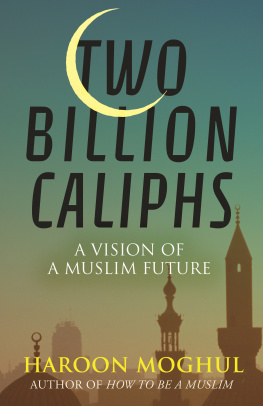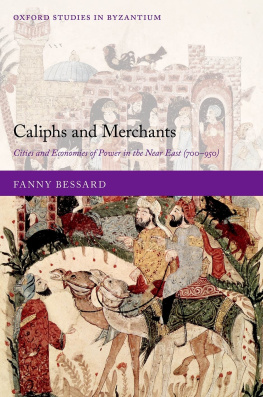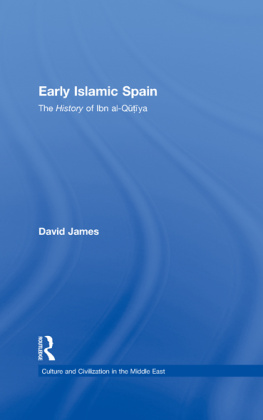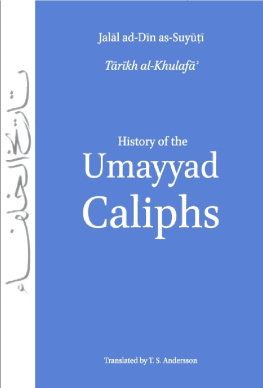El-Hibri - Parable and politics in early Islamic history: the Rashidun caliphs
Here you can read online El-Hibri - Parable and politics in early Islamic history: the Rashidun caliphs full text of the book (entire story) in english for free. Download pdf and epub, get meaning, cover and reviews about this ebook. City: New York, year: 2010;2011, publisher: Columbia University Press, genre: Religion. Description of the work, (preface) as well as reviews are available. Best literature library LitArk.com created for fans of good reading and offers a wide selection of genres:
Romance novel
Science fiction
Adventure
Detective
Science
History
Home and family
Prose
Art
Politics
Computer
Non-fiction
Religion
Business
Children
Humor
Choose a favorite category and find really read worthwhile books. Enjoy immersion in the world of imagination, feel the emotions of the characters or learn something new for yourself, make an fascinating discovery.
Parable and politics in early Islamic history: the Rashidun caliphs: summary, description and annotation
We offer to read an annotation, description, summary or preface (depends on what the author of the book "Parable and politics in early Islamic history: the Rashidun caliphs" wrote himself). If you haven't found the necessary information about the book — write in the comments, we will try to find it.
El-Hibri: author's other books
Who wrote Parable and politics in early Islamic history: the Rashidun caliphs? Find out the surname, the name of the author of the book and a list of all author's works by series.
Parable and politics in early Islamic history: the Rashidun caliphs — read online for free the complete book (whole text) full work
Below is the text of the book, divided by pages. System saving the place of the last page read, allows you to conveniently read the book "Parable and politics in early Islamic history: the Rashidun caliphs" online for free, without having to search again every time where you left off. Put a bookmark, and you can go to the page where you finished reading at any time.
Font size:
Interval:
Bookmark:

PARABLE AND POLITICS
IN EARLY ISLAMIC HISTORY

Columbia University Press
Publishers Since 1893
New York Chichester, West Sussex
cup.columbia.edu
Copyright 2010 Columbia University Press
All rights reserved
E-ISBN 978-0-231-52165-9
Library of Congress Cataloging-in-Publication Data
EL-Hibri, Tayeb.
Parable and politics in early Islamic history : the Rashidun caliphs / Tayeb El-Hibri.
p. cm.
Includes bibliographical references and index
ISBN 978-0-231-15082-8 (cloth : alk. paper)ISBN 978-0-231-52165-9 (ebook)
1. Islamic EmpireHistory622661Historiography. 2. CaliphsIslamic EmpireHistoriography. 3. CaliphateHistoriography. 4. ProphetsIslamic EmpireHistoriography. 5. Islam and politicsIslamic EmpireHistoriography. 6. Islamic parablesIslamic EmpireHistory.
7. HistoriographyPolitical aspectsIslamic Empire. 8. HistoriansIslamic EmpireHistory. I. Title.
DS38.16.E425 2010
909.1dc22
2010009473
A Columbia University Press E-book.
CUP would be pleased to hear about your reading experience with this e-book at .
References to Internet Web sites (URLs) were accurate at the time of writing. Neither the author nor Columbia University Press is responsible for URLs that may have expired or changed since the manuscript was prepared.

Contents

The study of the classical Islamic heritage remains something central not just for specialists of medieval history but also for those who study the modern Islamic world. Topics such as the caliphate, the division between Sh and Sunn, and the overall relevance of events and contentions that happened nearly fourteen centuries ago once again form crucial areas for reexamination and introspection. Even the casual reader of introductory writings on Islam can suddenly find himself forced to go beyond understanding the Qurn and the story of the Prophet to having to know about the reigns of the first four caliphs (Ab Bakr, Umar, Uthmn, and Al), who succeeded him in the years 632661, the period known as the Rshidn caliphate (lit. the Rightly Guided Rulers). The narrative of the expansion of the Islamic state into Sasanid Persia and the Byzantine empire, the idealized ascetic profiles of the early caliphs (who were also once companions of the Prophet), and the story of the sudden onset of succession crisis and civil war that followed the assassination of the third caliph, Uthmn, and the accession of Al are not mere political transitions folded in time but topics that continue to stir both passionate reverence and deep division in modern Islamic society.
The triumphant political careers of the Prophet and his successors, unlike the situation of Judaism and Christianity, have given this history a life of its own, and almost added understanding it in a particular way as an article of faith. Hence the Sha sect would have no identity without its advocacy for the higher stature of the Hshimite family of the Prophet generally, and Al and the line of imms among his descendants more particularly, when compared to the other companions of the Prophet and their descendants, while for the Sunns the faith would equally be diminished without the high reverence accorded to the first two caliphs specifically, Ab Bakr and Umar, and the collective importance of all the companions as a symbol of the collectivity of the community (the jama) more generally later. To debate the biographies of the early caliphs is therefore not analogous to writing the history of Roman Caesars but more like tracking the careers of the apostles of Jesus had they ever gone on to experience a cycle of political rise and decline. The dynasties of the Umayyads (661750), based in Damascus, and the Abbsids (7501258), based in Baghdad, would each lay claim to the titles of caliph and Commander of the Faithful, but a convention of religious authenticity among Sunns defines only the Rshidnand for the Sha only Alas the true caliphs. All later rulers are monarchs who had become removed from the utopian lifestyle of the early society of Medina.
Each of the two Islamic sects has long approached this history with firm conviction regarding one or the other of the two versions of how the dispute over the succession began and developed. The Sha believe that Al was deliberately wronged by the other companions when he was repeatedly passed over for the succession and later given the chance only after leadership of the community became a thankless task on the eve of a brewing conflict. To the Sha this was not only an affront to a more erudite and puritanical individuala veritable immbut almost a deliberate conspiracy against the very family of the Prophet (the Hshimites) to prevent them from holding leadership. And Als tragedy would only accelerate later, when he had to deal with overzealous followers, the Khrijites, who turned against him and became some of his staunchest opponents.
Sunns, however, believe that this Sh version of events falls somewhere between an exaggeration of Als importance and a complete conspiracy fantasy. The first two caliphs are viewed by Sunns as having been more senior than Al, with their own other important ties to the Prophet, and as crucial framers of the sunna (tradition) of the Prophet (sometimes sunna is directly associated with the Prophet, but at other times just with the first caliphs and the companionsand thus only indirectly recognized as authoritative custom). The first caliphs, and to an even greater extent their more junior associates, such as Ibn Abbs and Abdallh b. Umar, are equally viewed as crucial for the frame of adths (lit. sayings of the Prophet) that underlie the Shara.
A lot of the divergence in the religious concepts and institutions of Sunns and Shs therefore emanates from that initial disagreement over who should have succeeded the Prophet and what really happened on the eve of his deathdebates that created such a sudden rift in the community afterward. The present study revisits this original issue in religious and historical sources and argues for an alternative reading of this history as a largely parabolic cycle of literary narrative. Despite the seeming fragmentation of accounts about the first four caliphs, whether in adths or in historical stories, it is shown that these once formed a unified story with a particular plot line, with intertextual connections that conveyed a variety of allusive meanings about a political, polemical, or moralizing issue. These meanings would have been challenging but still accessible to an audience of the early Islamic period, which was steeped in the techniques of rhetorical argumentation and evocation. Such audiences were conscious of the potential layers of meaning in discussing issues and equally in command of learning across different cultures and their frames of presentation (Judaic, Christian, Arabic, Persian, folkloric, etc.). This awareness about the literary potential of caliphal history would gradually recede in importance in the ninth century with the emergence of different orthodoxies, Sunn and Sh, that narrowed the use of history to a mere factual reporting to support one official version or another. As the subsequent chapters will show, however, the partisan Sunn and Sh depictions of history or of historical characters both basically drew on the same collection of narratives. The emergent picture in this study will be that of an originally well-structured drama of strong and weak points for each central characterrather than one of a completely favorable or unfavorable image for one character over another.
Next pageFont size:
Interval:
Bookmark:
Similar books «Parable and politics in early Islamic history: the Rashidun caliphs»
Look at similar books to Parable and politics in early Islamic history: the Rashidun caliphs. We have selected literature similar in name and meaning in the hope of providing readers with more options to find new, interesting, not yet read works.
Discussion, reviews of the book Parable and politics in early Islamic history: the Rashidun caliphs and just readers' own opinions. Leave your comments, write what you think about the work, its meaning or the main characters. Specify what exactly you liked and what you didn't like, and why you think so.







